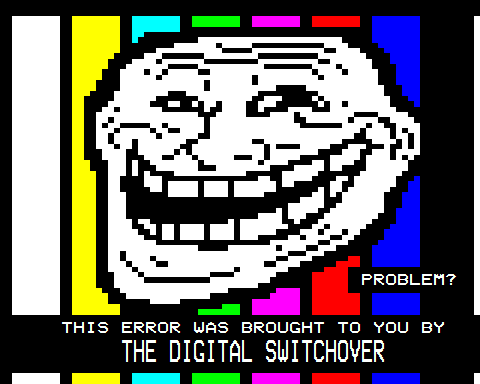Teletext technical history
- Conception and invention of medium.
- Early 1970s. Developed and created by the BBC, who were initially researching a method of closed captioning.
- Technological updates/upgrades
- Mid-1970s update to include 8 colours.
- Level 1.0 and 2.5 teletext - more updated graphics but not used by any TTX broadcaster in Britain.
- Significant dates and events in TTX's technical history.
- 1980 - Pages From Ceefax first broadcast. 2005 - service ended. (Case study for the lifespan of the medium?
- Relaunches and redesigns. 1996.
- The birth and death of teletext. 2012 switch off, gradual phasing out of the medium.
- Teletext
- 'Ceefax' (BBC) coming first in 1973
- 'ORACLE' (ITV) following soon after
- Viewdata - Post Office's method of transmitting text via telephone lines. 'Prestel'.
- The teletext umbrella.
- Collaboration of Ceefax, ORACLE and Prestel to create the collective term teletext, 1976 - 'Broadcast Teletext Specification'.
- The single aesthetic which was agreed upon - 40x24 grid of text with some graphic characters - CEPT1.
- 1980s - Videotex. Minitel - TV with computer keyboard incorporated used to control. Not adopted in Britain.
- 1960s. ARPANET. Information retrieval service/communication method. Early network. Precursor to internet.
- Late 1960s. Arcade video games. Precursor to teletext.
- 1970s. Development of the computer GUI. Similar aesthetic to teletext, pixel medium. Moved away from this similarity, however.
- 1990s. The early Internet. Transmission of plain text information. Few images.
- 2000. Internet boom. Teletext and internet - comparisons/contrasts.
- 2000. Interactive television - successor to teletext. Retains many features/functions
- Function of each medium, with regards to teletext.
- Popularity.
- First electronic information retrieval system.
- Regular updates at the peak of its popularity.
- Sep 11 01 attacks - when Internet down, TTX provided people with service. Probably last thing TTX will be known for.
- Uses.
- Transmitting/finding information - pools news, lottery, football results.
- Playing games. Bamboozle multiple choice. Quiz questions - reveal button.
- Discussion 'forum'. Viewer opinions on music, TV, entertainment etc.
- Closed captioning method to aid hard of hearing.
- Peoples' opinions on the phasing out and subsequent 'death' of the medium.
- Sad to see it go. Nostalgic reasons, preference - simplicity.
- Many don't use it anyway. Internet and interactive TV used instead. 24hr news channels.
- Teletext humour.
- Use in media - parody.
- Naked News piece (video no longer on YouTube)
- Look Around You DVD
- Alexei Sayle's STUFF, The Wootton Project
- Use of the medium to provide humour
- Tom Moody's (Untitled) Teletext project
- Paramount Comedy's inserts for broken pages
- Teletext cartoons, kids' corner
- The teletext aesthetic emulated within the internet browser
- Jodi - 'Text'. Teletext style font set formatted for web browser.
- Unterberger-Probst - 'Framed'. TTX aesthetic emulated and embedded into web browser.
- Tarmo Tanilsoo - ES5DWXL. Personal web site. TTX aesthetic emulated and embedded into web browser.
- Work broadcast on teletext
- Lektrolab - Teletext art broadcast on Teletext in Netherlands. Created using Cebratext, later reformatted for computer format.
- Tom Moody - Untitled teletext project. Pages for broadcast on teletext.
- Data Design - Commercial teletext pages - MTV, racing teletext etc.
- The pixel - works that share a similar pixellated aesthetic.
- Paul Slocum - Windows GUI formatted for Atari. Use of Atari emulator.
- Cory Arcangel - Landscape series, video game art. Pixellated aesthetic similar to teletext.
- Eboy - Pixellated aesthetic borrowing from Sim City video game idea/aesthetic. How contemporary artists use the pixel aesthetic originally employed by teletext as a commercially successful format.



0 comments:
Post a Comment